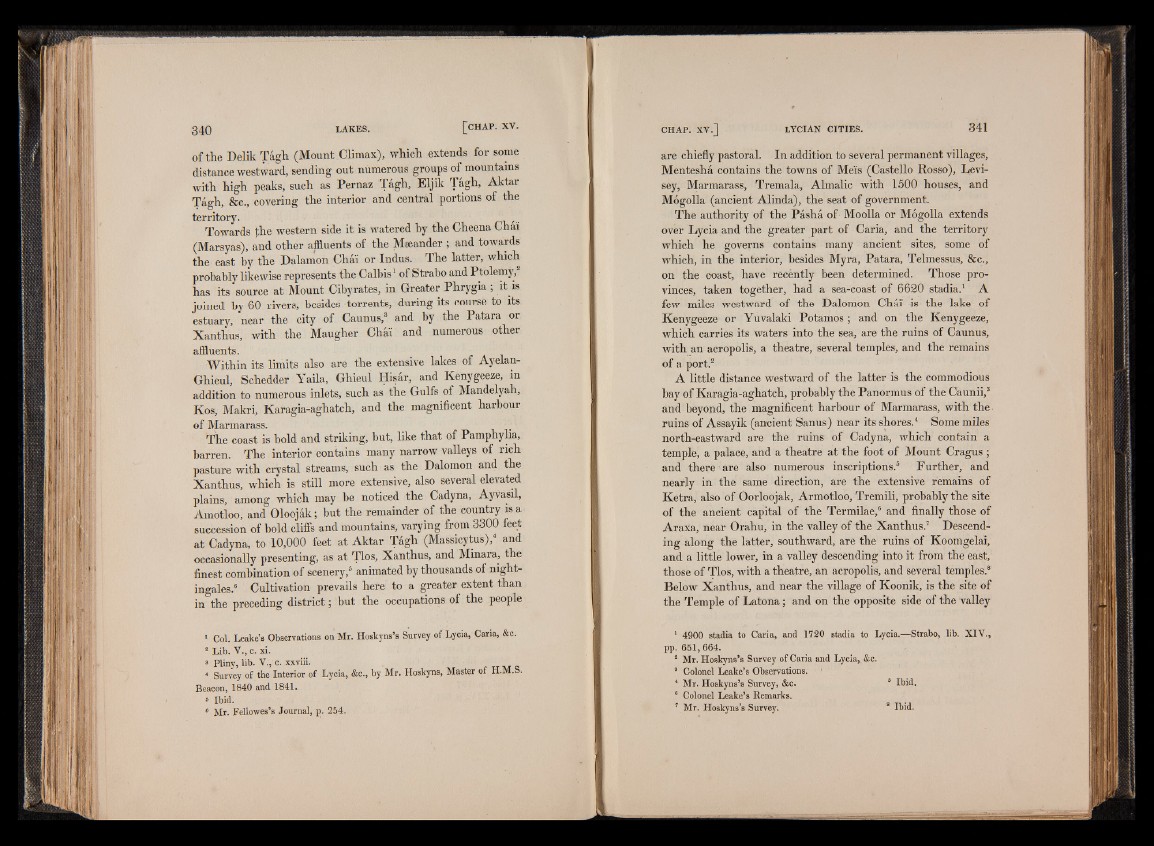
of the Delik Tagh (Mount Climax), which extends for some
distance westward, sending out numerous groups of mountains
with high peaks, such as Pernaz Tagh, Eljik Tagh, Aktar
Tagh, &c., covering the interior and central portions of the
territory. rn.'-
Towards the western side it is watered by the Cheena Chai
(Marsyas), and other affluents of the Mseander ; and towards
the east by the Dalamon Chai or Indus. The latter, which
probably likewise represents the Calbis1 of Strabo and Ptolemy,2
has its source at Mount Cibyrates, in Greater Phrygia ; it is
joined by 60 rivers, besides torrents, during its course to its
estuary, near the city of Caunus,3 and by the Patara or
Xanthus, with the Maugher Chai and numerous other
affluents.
Within its limits also are the extensive lakes of Ayelan-
Ghieul, Schedder Yaila, Ghieul His4r, and Kenygeeze, in
addition to numerous inlets, such as the Gulfs of Mandelyah,
Kos, Makri, Karagia-aghatch, and the magnificent harbour
of Marmarass.
The coast is bold and striking, but, like that of Pamphylia,
barren. The interior contains many narrow valleys of rich
pasture with crystal streams, such as the Dalomon and the
Xanthus, which is still more extensive, also several elevated
plains, among which may be noticed the Cadyna, Ayvasil,
Amotloo, and Oloojak; but the remainder of the country is a
succession of bold cliffs and mountains, varying from 3300 feet
at Cadyna, to 10,000 feet at Aktar Tagh (Massicytus),4 and
occasionally presenting, as at Tlos, Xanthus, and Minara, the
finest combination of scenery,6 animated by thousands of nightingales.
6 Cultivation prevails here to a greater extent than
in the preceding district; but the occupations of the people
1 Col. Leake’s Observations on Mr. Hoskyns’s Survey of Lycia, Caria, &c.
2 Lib. V., c. xi.
3 Pliny, lib. V., c. xxviii.
* Survey of the Interior of Lycia, &c., by Mr. Hoskyns, Master of H.M.S.
Beacon, 1840 and 1841.
5 Ibid.
6 Mr. Fellowes’s Journal, p. 254.
are chiefly pastoral. In addition to several permanent villages,
Mentesha contains the towns of Me'is (Castello Rosso), Levi-
sey, Marmarass, Tremala, Almalic with 1500 houses, and
Mogolla (ancient Alinda), the seat of government.
The authority of the Pasha of Moolla or Mogolla extends
over Lycia and the greater part of Caria, and the territory
which he governs contains many ancient sites, some of
which, in the interior, besides Myra, Patara, Telmessus, &c.,
on the coast, have recently been determined. Those provinces,
taken together, had a sea-coast of 6620 stadia.1 A
few miles westward of the Dalomon Chai is the lake of
Kenygeeze or Yuvalaki Potamos ; and on the Kenygeeze,
which carries its waters into the sea, are the ruins of Caunus,
with an acropolis, a theatre, several temples, and the remains
of a port.2
A little distance westward of the latter is the commodious
bay of Karagia-aghatch, probably the Panormus of the Caunii,3
and beyond, the magnificent harbour of Marmarass, with the
ruins of Assayik (ancient Sanus) near its shores.4 Some miles
north-eastward are the ruins of Cadyna, which contain a
temple, a palace, and a theatre at the foot of Mount Cragus ;
and there' are also numerous inscriptions.5 Further, and
nearly in the same direction, are the extensive remains of
Ketra, also of Oorloojak, Armotloo, Tremili, probably the site
of the ancient capital of the Termilae,6 and finally those of
Araxa, near Orahu, in the valley of the Xanthus.7 Descending
along the latter, southward, are the ruins of Koomgelai,
and a little lower, in a valley descending into it from the east,
those of Tlos, with a theatre, an acropolis, and several temples.8
Below Xanthus, and near the village of Koonik, is the site of
the Temple of Latona; and on the opposite side of the valley
1 4900 stadia to Caria, and 1720 stadia to Lycia.—Strabo, lib. XIV.,
pp. 651, 664.
2 Mr. Hoskyns’s Survey of Caria and Lycia, &c.
2 Colonel Leake’s Observations. '
4 Mr. Hoskyns’s Survey, &c. 5 Ibid.
6 Colonel Leake’s Remarks.
7 Mr. Hoskyns’s Survey. 8 Ibid.